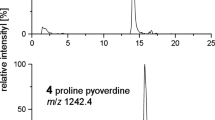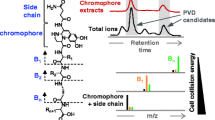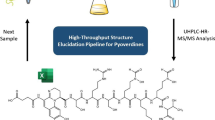Abstract
The previously unknown sequences of several pyoverdines (PVD) produced by a biotechnologically-relevant bacterium, namely, Pseudomonas taiwanensis VLB120, were characterized by high performance liquid chromatography (HPLC)–high resolution mass spectrometry (HRMS). The same structural characterization scheme was checked before by analysis of Pseudomonas sp. putida KT2440 samples with known PVDs. A new sample preparation strategy based on solid-phase extraction was developed, requiring significantly reduced sample material as compared to existing methods. Chromatographic separation was performed using hydrophilic interaction liquid chromatography with gradient elution. Interestingly, no signals for apoPVDs were detected in these analyses, only the corresponding aluminum(III) and iron(III) complexes were seen. The chromatographic separation readily enabled separation of PVD complexes according to their individual structures. HPLC-HRMS and complementary fragmentation data from collision-induced dissociation and electron capture dissociation enabled the structural characterization of the investigated pyoverdines. In Pseudomonas sp. putida KT2240 samples, the known pyoverdines G4R and G4R A were readily confirmed. No PVDs have been previously described for Pseudomonas sp. taiwanensis VLB120. In our study, we identified three new PVDs, which only differed in their acyl side chains (succinic acid, succinic amide and malic acid). Peptide sequencing by MS/MS provided the sequence Orn-Asp-OHAsn-Thr-AcOHOrn-Ser-cOHOrn. Of particular interest is the presence of OHAsn, which has not been reported as PVD constituent before.



Similar content being viewed by others
References
Alpert AJ (1990) Hydrophilic-interaction chromatography for the separation on peptide, nucleic acids and other polar compounds. J Chrom A 499:177–196
Braud A, Hoegy F, Jezequel K, Lebeau T, Schalk IJ (2009) New insights into the metal specificity of the Pseudomonas aeruginosa pyoverdine-iron uptake pathway. Environ Microbiol 11:1079–1091. doi:10.1111/j.1462-2920.2008.01838.x
Budzikiewicz H (1993) Secondary metabolites from fluorescent pseudomonads. FEMS Microbiol Rev 10:209–228. doi:10.1111/j.1574-6968.1993.tb05868.x
Bultreys A, Gheysen I, Wathelet B, Maraite H, de Hoffmann E (2003) High-performance liquid chromatography analyses of pyoverdin siderophores differentiate among phytopathogenic fluorescent Pseudomonas species. Appl Environ Microbiol 69:1143–1153. doi:10.1128/AEM.69.2.1143-1153.2003
Chaturvedi V, Kumar A (2014) Metabolism dependent chemotaxis of Pseudomonas aeruginosa N1 towards anionic detergent sodium dodecyl sulfate. Indian J Microbiol 54:134–138. doi:10.1007/s12088-013-0426-8
Chen H, Thomas MG, O’Connor SE, Hubbard BK, Burkart MD, Walsh CT (2001) Aminoacyl-S-enzyme intermediates in beta-hydroxylations and alpha, beta-desaturations of amino acids in peptide antibiotics. Biochemistry 40:11651–11659
Fuchs R, Schafer M, Geoffroy V, Meyer J-M (2001) Siderotyping a powerful tool for the characterization of pyoverdines. Curr Top Med Chem 1:31–57. doi:10.2174/1568026013395542
Greenwald J, Zeder-Lutz G, Hagege A, Celia H, Pattus F (2008) The metal dependence of pyoverdine interactions with its outer membrane receptor FpvA. J Bacteriol 190:6548–6558. doi:10.1128/JB.00784-08
Johnsen J (1981) Presence of ß-lactamase and penicillin acylase in a Pseudomonas sp. utilizing benzylpenicillin as a carbon source. J Gen Appl Microbiol 27:499–503
Kilz S, Lenz C, Fuchs R, Budzikiewicz H (1999) A fast screening method for the identification of siderophores from fluorescent Pseudomonas spp. by liquid chromatography/electrospray mass spectrometry. J Mass Spectrom 34:281–290
Köhler KA, Rückert C, Schatschneider S, Vorhölter FJ, Szczepanowski R, Blank LM, Niehaus K, Goesmann A, Pühler A, Kalinowski J, Schmid A (2013) Complete genome sequence of Pseudomonas sp. strain VLB120 a solvent tolerant, styrene degrading bacterium, isolated from forest soil. J Biotechnol 168:729–730. doi:10.1016/j.jbiotec.2013.10.016
Lin Z, Falkinham JO 3rd, Tawfik KA, Jeffs P, Bray B, Dubay G, Cox JE, Schmidt EW (2012) Burkholdines from Burkholderia ambifaria: antifungal agents and possible virulence factors. J Nat Prod 75:1518–1523. doi:10.1021/np300108u
Linget C, Azadi P, MacLeod JK, Dell A, Abdallah MA (1992) Bacterial siderophores: the structures of the pyoverdins of Pseudomonas fluorescens ATCC 13525. Tetrahedron Lett 33:1737–1740
Merz C, Demange P, Cung MT, Dell A, Linget C, Abdallah MA (1991) Bacterial siderophores: the conformation of diamagnetic complexes of Pseudomonas aeruginosa pyoverdin. J Inorg Chem 43:142. doi:10.1016/0162-0134(91)84136-W
Meyer J-M, Gruffaz C, Raharinosy V, Bezverbnaya I, Schäfer M, Budzikiewicz H (2007) Siderotyping of fluorescent Pseudomonas: molecular mass determination by mass spectrometry as a powerful pyoverdine siderotyping method. Biometals 21:259–271. doi:10.1007/s10534-007-9115-6
Panke S, Witholt B, Schmid A, Wubbolts MG (1998) Towards a biocatalyst for (S)-styrene oxide production: characterization of the styrene degradation pathway of Pseudomonas sp. strain VLB120. Appl Environ Microbiol 64:2032–2043
Park JB, Buhler B, Panke S, Witholt B, Schmid A (2007) Carbon metabolism and product inhibition determine the epoxidation efficiency of solvent-tolerant Pseudomonas sp. strain VLB120DeltaC. Biotechnol Bioeng 98:1219–1229. doi:10.1002/bit.21496
Qi Y, Hayen H, Volmer DA (2016) Characterization of the iron-binding properties of pyoverdine using electron-capture dissociation-tandem mass spectrometry. Biometals 29:53–60. doi:10.1007/s10534-015-9895-z
Roepstorff P, Fohlmann J (1984) Letter to the editors. Biomed Mass Spectrom 11:601
Salah el Din AL, Kyskik P, Stephan D, Abdallah MA (1997) Bacterial iron transport: structure elucidation by FAB-MS and by 2D NMR (1H, 13C, 15N) of pyoverdin G4R, a peptidic siderophore produced by a nitrogen-fixing strain of Pseudomonas putida. Tetrahedron 53:12539–12552
Tawfik KA, Jeffs P, Bray B, Dubay G, Falkinham JO, Mesbah M, Youssef D, Khalifa S, Schmidt EW (2010) Burkholdines 1097 and 1229, potent antifungal peptides from Burkholderia ambifaria 2.2N. Org Lett 12:664–666. doi:10.1021/ol9029269
Weber G, von Wiren N, Hayen H (2008) Hydrophilic interaction chromatography of small metal species in plants using sulfobetaine- and phosphorylcholine-type zwitterionic stationary phases. J Sep Sci 31:1615–1622. doi:10.1002/jssc.200800060
Wei H, Aristilde L (2015) Structural characterization of multiple pyoverdines secreted by two Pseudomonas strains using liquid chromatography-high resolution tandem mass spectrometry with varying dissociation energies. Anal Bioanal Chem 407:4629–4638. doi:10.1007/s00216-015-8659-5
Winkler S, Ockels W, Budzikiewicz H, Korth H, Pulverer G (1986) 2-Hydroxy-4-methoxy-5-methylpyridin-N-oxid ein Al3+ bindender Metabolit von Pseudomonas cepacia. Z Naturforsch 41c:807–808
Acknowledgements
The authors acknowledge Dr. Till Tiso and Prof. Dr. Lars M. Blank (Institute of Applied Microbiology, RWTH Aachen University, Germany) for providing the Pseudomonas putida sample materials and HILICON AB for providing the iHILIC® Fusion column. Georgina Thyssen and Michael Holtkamp (Institute of Inorganic and Analytical Chemistry, University of Münster, Germany) are acknowledged for the TXRF and ICP-MS measurements. We also thank Dr. Benedikt Cramer (Institute for Food Chemistry, University of Münster, Germany) for technical assistance during LTQ Orbitrap measurements and access to the instrument. DAV acknowledges research support by the Alfried Krupp von Bohlen und Halbach-Stiftung and DFG (FTICR-MS Facility, INST 256/356-1).
Author information
Authors and Affiliations
Corresponding author
Electronic supplementary material
Below is the link to the electronic supplementary material.
Rights and permissions
About this article
Cite this article
Baune, M., Qi, Y., Scholz, K. et al. Structural characterization of pyoverdines produced by Pseudomonas putida KT2440 and Pseudomonas taiwanensis VLB120. Biometals 30, 589–597 (2017). https://doi.org/10.1007/s10534-017-0029-7
Received:
Accepted:
Published:
Issue Date:
DOI: https://doi.org/10.1007/s10534-017-0029-7




